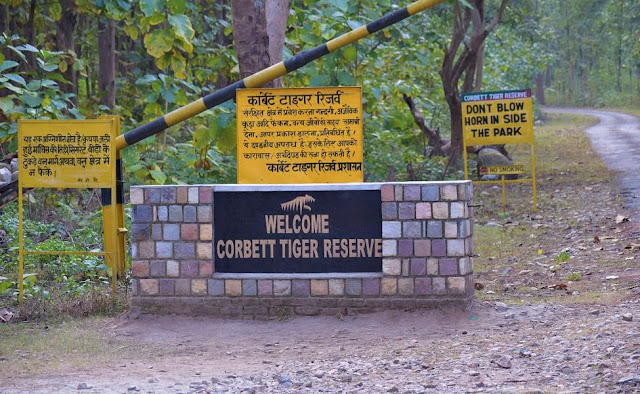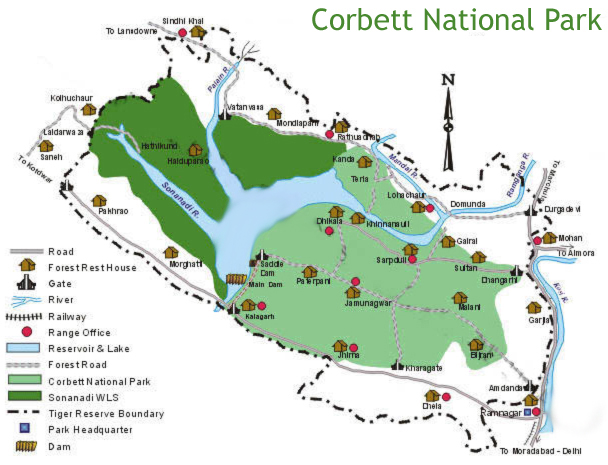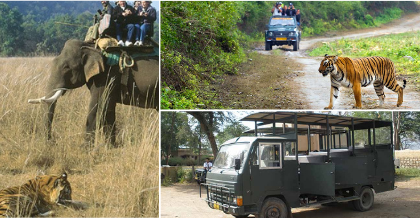Know About Jim Corbett National Park
Located in the district of Nainital, Corbett National Park is a perfect place for nature enthusiasts and wildlife lovers. Named after the renowned British-Indian hunter and tracker-turned-conservationist, the tourist places in Corbett National Park have a mystical status when it comes to wildlife holidays in India. This oldest national park in India is home to abundant flora and fauna and promises to offer quintessential experiences through its safari. The popularity of Corbett national Park is due to the presence of Royal Bengal Tiger in abundance and the captivating landscape for the delight of nature lovers.
Not only wildlife, the park has a good population of bird species and is quite known for fishing and angling as well. Also, with so many wildlife resorts, it’s loved by luxury travellers. Situated on the foothills of Himalayas, this ‘Paradise of Tigers’ is the key to escape from the vivid city lights and constant traffic roar. A Jim Corbett tour will take you on an adventure through lush green hills, reverie belts, water holes and 521 sq km of abounding animal and plant kingdom.
For better administration and tourist flow, Jim Corbett has been divided into six tourism zones, that attract thousands of foreign and Indian visitors every year. When we speak about the tourist places in Corbett, Dhikala zone is the largest and is highly recommended for wildlife enthusiasts as it is home for many animals, primarily tigers. Bijrani zone is also very popular among tourists and is easily accessible from Ramnagar, so is Jhirna. Durga Devi, another prominent zone is known for bird watching. Even though Sitabani zone doesn’t fall under the Corbett Tiger Reserve area, it’s an ideal place to be visited and is adored by nature lovers due to its serene ambience.
Flora and Fauna Of Jim Corbett National Park:
National Parks have their distinct flora which comprises the freshwater flora and alpine flora. The prominent alpine flora includes Sal forests, Chaurs, Khair-Sissoo forests and much more. The river plants on other hand have its own distinctive hierarchy. There are over 600 species of trees, shrubs, herbs, bamboos, grasses, climbers and ferns in the Jim Corbett National Park.
Some of the ubiquitous trees in Corbett are Sal, Sissoo and Khair. Many other species that contribute to the diversity here, are found scattered throughout the park. Pine (Chir) is the only conifer found in premises of the park and is found on ridge-tops like ChinChoti, though at Gajar Sot, its density becomes quite low. On the elevated levels near Kanda, Banj Oak is easily seen, which is truly a Himalayan species. Prominent Palm species are Date Palms found in the open and well-lighted areas. Kanju (Holopteliaintegrifolia), Jamun (Syzygiumcumini) and Aamla (Emblica Officinalis) are seen in the moist areas. Other tree species comprise Bel, Kusum, Mahua and Bakli.
Fauna in Jim Corbett National Park:
One of the well-known species of animals inhabiting Jim Corbett is the Royal Bengal Tiger. It was in the forests of Jim Corbett that India’s tiger conservation program was initiated on 1st April 1973. There was a time when there were many man-eating tigers which dominated the Terai-Bhabar region. However, with a recent decline in the population of tigers, the attacks on tigers have become quite a rare occurrence. Adult tigers could be seen as solitary wanderers to the tourists, whereas tigresses could be spotted with young cubs.
Leopards can be easily located in the hilly areas but can also be seen around in the lowland jungles. Smaller-size feline population comprises the Jungle Cat, Fishing Cat and Leopard Cat. Other mammals inhabiting Jim Corbett National park includes deer species (Barking, Sambhar, Hogg and Chital), Sloth bears and Himalayan Black bears, Indian Grey Mongoose, otters, Elephants, Yellow Throated Martens, Ghoral (Goat-Antelopes), Indian Pangolins, and Langur and Rhesus Monkeys. Tourists can also spot Owls and Nightjars during the night. Local crocodiles (along with the banks of the Ram Ganga River) and Indian Python, King Cobra, Common Cobra could also be seen in the Jim Corbett Park.
Zones In Jim Corbett
- The Tourist Zones
- Bijrani Safari Zone
- Jhirna Safari Zone
- Dhela Safari Zone
- Dhikala Zone
- Durga Devi Zone
- Sitabani Buffer Zone
Different Kinds Of Jim Corbett Safari types :
- Jeep safari
- Canter safari
- Elephant safari
How to Reach Corbett :
Ramnagar is perhaps the best approach to the Corbett National Park which forms the headquarters of CTR. This small city is well connected by road and rail network with major cities of India like Delhi, Moradabad, Nainital and Bareilly. Once you reach Ramnagar, then it takes only half an hour to reach Corbett National Park. The park is around 15 Kms from Ramnagar railway station.
By Road :
Ramnagar has a very good network of road that connects the different cities. The Corbett National Park is situated at an approximate surface distance of 260 Kilometer from India's national capital Delhi. The state government of Uttarakhand plies buses at a short interval of time from Delhi, Moradabad, Haldawani, and Nainital that reaches Corbett directly.
By Rail :
The railway station in Ramnagar receives trains from different major cities of India like Delhi, Moradabad and Bareilly. A direct train to Ramnagar runs from Delhi. You can check out for Ranikhet Express, Corbett Link Express and Kathgodam Express that takes you directly to Ramnagar.
How To Get Customised Jim Corbett Booking


